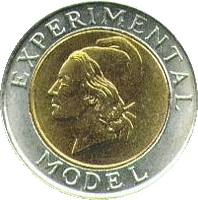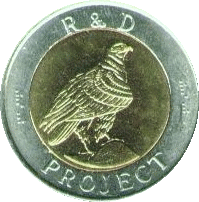
OBVERSE

![]()
REVERSE & ENLARGEMENT OF
BRAILLE AREA
Schuler
Pressen Prototype |
|
|
NOTE: The following information is generously provided by Small Dollar researcher and enthusiast Phillip Barnhart.
This pattern is the approximately the size of an SBA and Sacagawea Dollar (off about a half-millimeter to comply with government regulation), with a nickel/brass core and cupronickel ring with imbedded security features and conductance-enhancement for U. S. clad coinage compatibility. The obverse is loosely based on 19th century U. S. patterns; the reverse is an eagle. The Braille letters are "REV" for "reverse." Struck in Michigan at the Schuler offices for the U. S. Mint and congressional hearings.}
Here is the story of this pattern from 1997. Schuler had been both trying to demonstrate the advantages to the US Mint of using Schuler technology from imbedding security and Braille and other tactile features.
The story behind this pattern - struck by Schuler Pressen in a demonstration for congressional representatives and the U.S. Mint - has been a difficult item to research. Both the U.S. Mint and Schuler have been reluctant to confirm how this pattern was struck. But the following information comes from sources including Gallery Mint Museum, the office of Rep. Mike Castle, the U. S. Sales Office of Schuler Pressen (Michigan - who I had contact with when working for Ford), and the late director of the Coin Coalition. So stick with me here . . .
In 1997, the US Mint researched the concerns of the Alliance for the Blind, a Coin Coalition partner. The Alliance had not been happy with the response to the report from the National Academy of Science on using Braille on currency. Italy had experimented with Braille on coinage in the early 1980's and Costa Rica was planning to use Braille on all its own coinage (see the 1999-2000 Costa Rican mint sets).
At the same time as the Braille coinage debate had heated up, Schuler Pressen, AG, was aiming for new business at the U.S. Mint.
If you thought it was hard to distinguish an SBA from a quarter, imagine how hard it would be for the sight-impaired. Part of the 1997 dollar coin debate was about this very subject - which is why the Alliance had joined with the Coin Coalition in promoting a new dollar coin. The United States Dollar Coin Act of 1997 required that the new dollar have an edge and other features to make it easily discernible for the blind.
Schuler struck several bi-metallic patterns (approximately 20) for congressional hearings and industry discussions to demonstrate these features, as well as promoting a bi-metallic coin that would be SBA-vending machine compliant.
The mint, not too happy with the flow of the debate, did not want to use Braille in any strikes. A senior mint official leaked an internal study (reportedly using these Schuler pieces) to several media outlets.
However, the U.S. Mint continued to get pressure. In late 1998, PMX Corporation - with the then leading alloy for the new dollar coin provided Nordic Gold planchets for a test using Martha Washington dies on a Schuler press (most likely in Michigan and not at PMX or the U. S. Mint). A POSSIBLE example of this second test appears on the USPatterns.com website.
In the end, Schuler got the mint contract, the Alliance conceded that the Sacagawea Dollar's smooth edge was distinctive enough (for now - they are still pushing for currency changes), and an interesting piece of numismatic history appears.
This pattern does NOT meet the conductance values of any US coin - this of course would be illegal. Information concerning this was provided in conversation with the Coin Coalition in late 1999 - which is when I was informed of the Braille tests on the Martha dollar. The Martha Braille strikes have actually been known to a few collectors for several years. The statement that the known Martha Braille pieces (2?) are on PMX alloy was inferred by both the appearance of the coin (brilliant and highly reflective) and a conversation with PMX's parent - Poongsan Corporation / Korea - in mid 1999. I have NOT examined to piece whose photograph appears at USPatterns.com and it may very well be a different alloy and represent a different test. Also, as far as I know the "Braille" on the Martha test pieces are nonsensical and do not represent anyone's initials or company name.